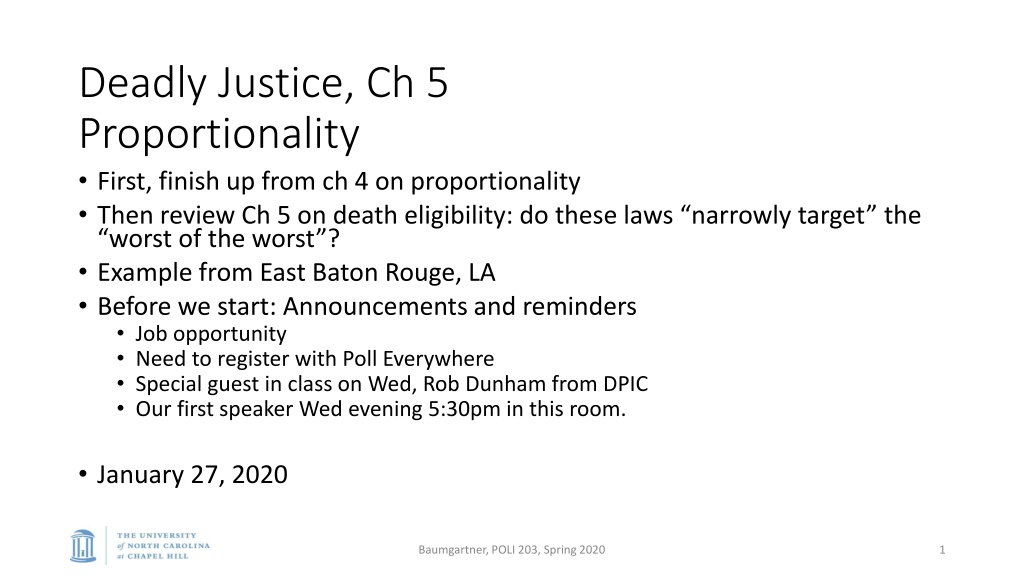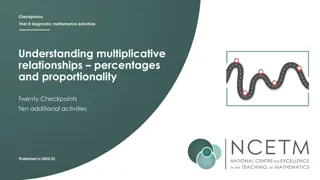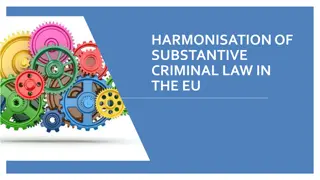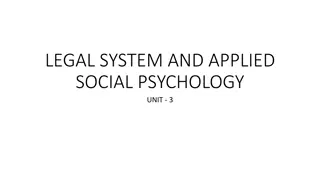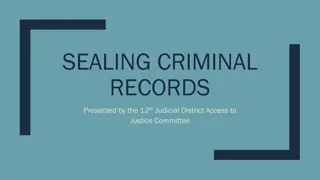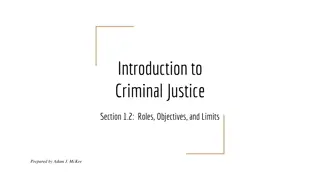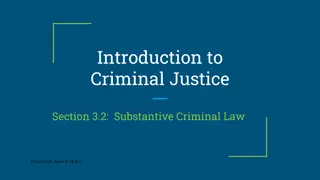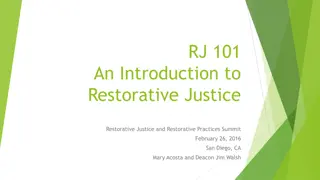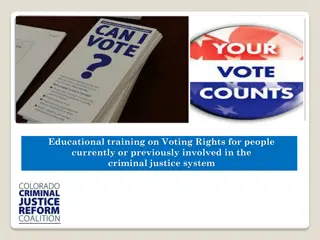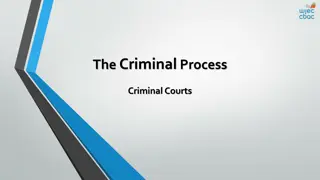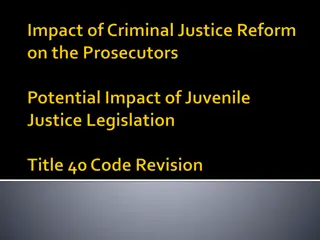Understanding Death Eligibility Laws and Proportionality in Criminal Justice
Exploring the concept of proportionality in death eligibility laws, focusing on the narrow targeting of offenders and the assessment of cases for the death penalty. Examples and discussions from legal cases and studies are presented to evaluate the effectiveness and fairness of these laws.
Download Presentation

Please find below an Image/Link to download the presentation.
The content on the website is provided AS IS for your information and personal use only. It may not be sold, licensed, or shared on other websites without obtaining consent from the author. Download presentation by click this link. If you encounter any issues during the download, it is possible that the publisher has removed the file from their server.
E N D
Presentation Transcript
Deadly Justice, Ch 5 Proportionality First, finish up from ch 4 on proportionality Then review Ch 5 on death eligibility: do these laws narrowly target the worst of the worst ? Example from East Baton Rouge, LA Before we start: Announcements and reminders Job opportunity Need to register with Poll Everywhere Special guest in class on Wed, Rob Dunham from DPIC Our first speaker Wed evening 5:30pm in this room. January 27, 2020 Baumgartner, POLI 203, Spring 2020 1
A job opportunity that came across my desk. This is all I know; ask them not me for details! I m not endorsing this and in fact I know nothing about it But I am glad to pass it on so you can check it out. DART will hold an online info session on Tuesday, February 4 at 7 pm to discuss careers in community organizing. All UNC students and alumni welcome, particularly those graduating before January 2021. RSVP at http://thedartcenter.nationbuilder.com/feb4?recruiter_id=113463 DART organizations unite congregations to work for social, economic and racial justice, including: Plugging the school-to-prison pipeline Reining in predatory lending practices Expanding access to primary health and dental care Prioritizing funding for affordable housing and job training Fighting for immigrants' rights Police accountability Positions start August 10, 2020 and January 11, 2021 in: South Carolina: Charleston Florida: St. Petersburg, Tampa, Sarasota, Lakeland, Ft. Myers, Fort Lauderdale, West Palm Beach, Daytona Beach, Miami Kentucky: Louisville, Lexington Kansas: Lawrence Virginia: Richmond Starting salary $39,064/year + benefits. DART organizations are largely made up of low- and moderate-income, minority and immigrant communities. We strongly encourage people from these backgrounds, as well as fluent Spanish speakers, to apply. To apply or learn more about DART, visit http://www.thedartcenter.org Still have questions? Contact hannah@thedartcenter.org or 202-841-0353. Baumgartner, POLI 203, Spring 2020 2
From Chapter 4: Narrow Targeting, Substantial Proportion, Proportionality Review From Furman: Narrowly target the class of eligible offenders to those who commit particular crimes But what if the DA lobbies the legislature and says: give me the discretion to seek death in cases that are just beyond the pale: especially heinous atrocious, and cruel (EHAC). You can trust me to use this discretion wisely. So, we need to assess: did the legislatures write narrowly targeted laws, or did they put in some wiggle room for DA s to cover other deserving cases ? Substantial proportion: among those who did such crimes, a substantial proportion (whatever that means) should get death Proportionality review: On direct appeal, state supreme court must review whether the case deserves it, compared to other cases How I would do this, as a social scientist; how the courts do this, in fact. Baumgartner, POLI 203, Spring 2020 3
Empirical Studies of Proportionality 1986, McCleskey v. Kemp David Baldus, law professor at University of Iowa. Leader of big team. Such studies have later been replicated many times. Start with a list of all capital-eligible crimes in a given state over a given time period, hopefully thousands of cases. Baldus did Georgia from 1973 to 1978. See Table 4.5; it has been replicated in lots of states, over different time periods. For every person who COULD HAVE received the death penalty, which ones did? Baumgartner, POLI 203, Spring 2020 4
Empirical Studies of Proportionality (cont.) Legally relevant factors Number of victims Rape or torture of victim (or more general measure of heinousness ) Previous felonies Statutory aggravators: killed a police officer, etc. Other things that are supposed to increase your odds Legally irrelevant factors Which county in the state; which year Your own race / gender / mental illness / poverty etc. Characteristics of the victim, beyond the statutory aggravators, such as race, gender Bad lawyer, bad legal strategy Baumgartner, POLI 203, Spring 2020 5
Empirical Studies of Proportionality (cont.) Results are very consistent Legally relevant factors do matter, indeed. But, controlling for those, so do the legally irrelevant matters. Logistic regression studies, statistical controls, effort to take seriously the question of proportionality None of the existing studies has failed to find statistically significant effects for legally irrelevant factors, especially race and gender of the victim Baumgartner, POLI 203, Spring 2020 6
John Donohues study of Connecticut, by way of New York Times http://www.nytimes.co m/2012/01/08/opinion/ sunday/the-random- horror-of-the-death- penalty.html Baumgartner, POLI 203, Spring 2020 7
USSC to Baldus: We Dont Care 1987 McCleskey v. Kemp Let s assume the professor s study is valid It doesn t matter. You must prove the INTENT to discriminate, in your individual case. General patterns are irrelevant Also, law students reviewing hundreds of cases and scoring them for heinousness is not the same as a jury sitting in a trial. So basically they deny the validity of large-scale comparisons, and by this make it impossible to assess proportionality Baumgartner, POLI 203, Spring 2020 8
Follow-up from McCleskey NC passed the Racial Justice Act in 2009 (more later this term), explicitly making it ok to do exactly what McCleskey disallowed. In other states, similar studies have been done to show the disproportionality / broken nature of the system, in hopes of getting the states to abolish: Connecticut (2012), Washington (abolished 2018), other states. At the federal level, Chief Justice Roberts recently referred to social science gobbledygook , but the debates continue. No longer any hope of having the death penalty declared unconstitutional solely because of racial bias (!). McCleskey was the end of the road for a long legal strategy. Since then, opponents have targeted a range of issues, not just race. Baumgartner, POLI 203, Spring 2020 9
Death Eligibility, Aggravators, and Mitigators Each state has to enumerate the crimes making the offender eligible for death. Often, those are the same as the legal aggravators: killing a small child, killing a police officer, killing after having been previously convicted of murder (e.g., you are a serial killer), etc. So, committing an aggravated murder makes you eligible. Mitigators: cannot be enumerated, juries can consider anything. Death eligibility: without these aggravators laid out in law, you cannot be tried capitally. You can t face the death sentence. Penalty phase: weigh the aggravators and the mitigators, for those found eligible and then convicted of a capital crime. Baumgartner, POLI 203, Spring 2020 10
Model Legal Code from the Amer. Bar Assn. (Table 5.2) Offender is in prison Repeat offender Multiple victims great risk of death to many persons Felony murder Avoid arrest or escape from prison pecuniary gain (murder for hire / mob hits / contract killing) especially heinous, atrocious, or cruel, manifesting exceptional depravity Baumgartner, POLI 203, Spring 2020 11
The big aggravators that expand the reach of the death penalty Felony murder Robbery Any break-in, assault, or other common crime is now death-eligible. Very few homicides, in fact, are NOT eligible, given that they are often committed during another crime, for example a robbery. Also, if you punch the victim before killing them, that s assault, a separate felony. Or if you restrain their movement, that s kidnapping. Note that by the law of parties even the non-trigger person, or accomplice in the felony is eligible for the full punishment. (Practically speaking, it means the trigger-person often turns against the others, knowing they face death, and the others think they can t possibly get it.) 11 people have been executed but did not kill the victim: https://deathpenaltyinfo.org/executions/executions-overview/executed-but-did-not- directly-kill-victim Baumgartner, POLI 203, Spring 2020 12
Big aggravators, cont. Especially heinous, atrocious, and cruel (EHAC) Exceptional depravity These make sense but it s hard to draw the line, and they provide very open discretion to a DA. ABA recommended it; DA s like the discretion on average, just so a case doesn t slip through, where there is heavy popular pressure, so many legislatures included this. Baumgartner, POLI 203, Spring 2020 13
Big aggravators, cont. Lying in wait (California) Future dangerousness (Texas) Pecuniary gain Contract killers, not that common. But if you take a bracelet from the victim, you made a financial gain, and the DA may use this to charge you capitally. Law presumably designed to target contract killers, but once on the books can be interpreted more broadly, and it has been. Risk to many Baumgartner, POLI 203, Spring 2020 14
Lets look at how this plays out in one place Capital and Non-Capital Murder Prosecutions in East Baton Rouge Parish, Louisiana, 2000 2016 I did this report based on data collected by the appellate defender s office in Baton Rouge, in March 2019 Part of an appeal from an inmate who was sentenced to death. His argument: he s not particularly more heinous or deserving than many others who committed homicide but did not get the same punishment. So we reviewed every homicide in that parish, over 17 years. Baumgartner, POLI 203, Spring 2020 15
550 homicides from East Baton Rouge, LA Baumgartner, POLI 203, Spring 2020 16
Offender characteristics, 86% black, 92% male, very young on average Baumgartner, POLI 203, Spring 2020 17
Victim characteristics: 74% black, 82% male, 91% just one victim, 550 offenders, 607 victims. Victims also pretty young, but not always. Baumgartner, POLI 203, Spring 2020 18
Offender victim racial combinations Black offenders: 10% white victims, 82% black victims White offenders: 58% white victims, 19% black victims Black offender, white victim: 47 cases of 550, 8% Black male offender, white female victim: 13 cases, 2% Baumgartner, POLI 203, Spring 2020 19
Aggravators Baumgartner, POLI 203, Spring 2020 20
Charges. Note that 2/3 had at least one aggravating factor Charge First degree, capital First degree, non-capital Second degree Lessor charges only Number Percent 35 53 460 6 10 84 0 2 Total 550 100 Baumgartner, POLI 203, Spring 2020 21
Punishments Punishment Offenders Percent Not guilty or no prison 67 12 Term sentence 267 49 Life in prison 146 27 Death 6 1 Unknown or not settled yet 64 12 Total 550 100 Baumgartner, POLI 203, Spring 2020 22
For the 267 who got a term sentence, how long was it? Baumgartner, POLI 203, Spring 2020 23
Legally relevant factors matter. But look how many still got second- degree Baumgartner, POLI 203, Spring 2020 24
Legally irrelevant factors also matter Baumgartner, POLI 203, Spring 2020 25
How irrelevant factors increase the odds of seeking death. Baumgartner, POLI 203, Spring 2020 26
A logistic regression model predicting capital prosecution. Predictor variable Odds- Ratio 2.24 Prob. Number of victims .138 Number of aggravators 3.36 .033 Black offender black victim 0.41 .107 White offender white victim White offender black victim 0.64 0.82 .617 .885 Black male offender white female victim 14.49 .003 Drug-related Victim less than 12 0.19 6.13 .076 .109 Victim greater than 64 13.8 .007 Other insignificant predictors included in the model: Arson, Burglary, Risk to Many, Drive-by, Prior killing, Kidnapping, Contract killing, cruelty to juveniles N = 458, pseudo-R2 = .3592 Baumgartner, POLI 203, Spring 2020 27
These findings similar to those of Baldus for Georgia Legally relevant factors do indeed increase the odds of facing capital punishment But they do not guarantee it. In fact, they are pretty weak, and many people see only 2nd degree charges Legally irrelevant factors matter, consistent with every study ever done. Response by the courts so far: We don t trust social science. Maybe there are other factors, such as attitude or lack of remorse, that are not controlled. DA s, judges, and juries can assess things that can t be quantified Baumgartner, POLI 203, Spring 2020 28
